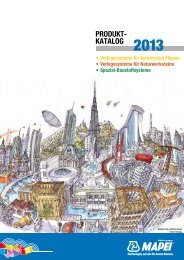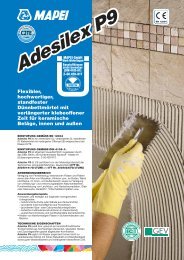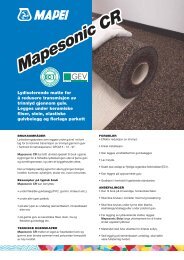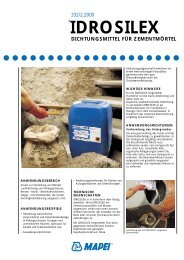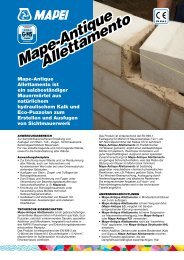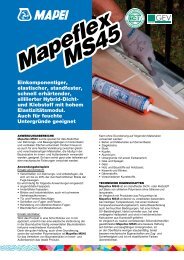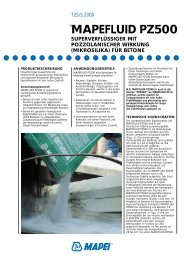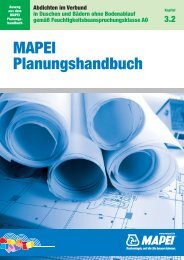Grinding aids for high performance cements
Grinding aids for high performance cements
Grinding aids for high performance cements
Create successful ePaper yourself
Turn your PDF publications into a flip-book with our unique Google optimized e-Paper software.
Cement Additives Division<br />
<strong>Grinding</strong> <strong>aids</strong> <strong>for</strong> <strong>high</strong> per<strong>for</strong>mance <strong>cements</strong><br />
M.Magistri, P.Recchi, Mapei SpA, Milan, Italy<br />
Introduction<br />
The interest in <strong>high</strong> per<strong>for</strong>mance <strong>cements</strong> has been growing in the last years, as a natural<br />
consequences of <strong>high</strong> per<strong>for</strong>mance concrete production. Cement producers are requested to offer<br />
in the market hydraulic binders with <strong>high</strong> early strengths, and this can be obtained by optimizing<br />
several parameters, ranging from clinker chemistry and reactivity to cement particle size<br />
distribution. The production of such <strong>high</strong> per<strong>for</strong>ming <strong>cements</strong> at a reasonable cost (from the point<br />
of view of clinker content and energy requirement <strong>for</strong> <strong>high</strong> fineness grinding) can be challenging<br />
and the use of suitable cement additives becomes mandatory. Several types of products can be<br />
found on the market. Whatever is the additive used (pure grinding <strong>aids</strong>, specifically designed to<br />
increase production and fineness, or per<strong>for</strong>mance enhancers with effect on cement hydration),<br />
the choice of the most appropriate relies on a detailed investigation that should consider all the<br />
characteristics of the cement.<br />
<strong>Grinding</strong> <strong>aids</strong> <strong>for</strong> <strong>high</strong> per<strong>for</strong>mance <strong>cements</strong><br />
<strong>Grinding</strong> <strong>aids</strong> are organic compounds that are added to the mill during cement grinding. Their<br />
main purpose is to reduce the energy required to grind the clinker into a given fineness. In<br />
addition, some products (usually referred to as per<strong>for</strong>mance enhancers) provide positive effect on<br />
cement hydration improving strength development [1]. In this paper we present a typical example<br />
of full investigation about the possibility of producing <strong>high</strong> early strength type I cement, using an<br />
appropriate cement additive.<br />
We were approached by a grinding plant with the target to produce a Portland cement (CEM I<br />
according to European standard EN 197-1) with early strengths as <strong>high</strong> as possible. The grinding<br />
plant has, <strong>for</strong> the production of <strong>high</strong>-per<strong>for</strong>mance <strong>cements</strong>, four different clinker sources<br />
available, here indicated as clinker 1, 2, 3 and 4. In our lab a detailed investigation was per<strong>for</strong>med,<br />
consisting in the following main points:<br />
1. clinkers characterization;<br />
2. investigation about clinkers’ grindability and reactivity;<br />
3. optimum cement composition;<br />
4. choice of the most appropriate cement additive, on the basis of the data collected.<br />
Clinkers characterization<br />
The four clinkers were characterized using the following techniques:<br />
- X-Ray fluorescence (XRF);<br />
- determination of loss on ignition and chemical analysis of free lime;<br />
- X-Ray diffraction (XRD) with Rietveld refinement.<br />
Results are reported in the table 1 (chemical composition) and table 2 (mineralogical<br />
composition).<br />
1
Cement Additives Division<br />
Clinker 1 Clinker 2 Clinker 3 Clinker 4<br />
Loss on ignition 0,15 % 0,21 % 0,18 % 0,14 %<br />
SiO 2 20,67 % 21,07 % 20,49 % 20,41 %<br />
Al 2 O 3 5,26 % 5,35 % 6,38 % 5,61 %<br />
Fe 2 O 3 3,18 % 3,85 % 2,18 % 2,89 %<br />
CaO 65,12 % 64,51 % 64,46 % 65,43 %<br />
MgO 2,10 % 1,61 % 3,09% 1,25 %<br />
K 2 O 0,68 % 0,71 % 0,48 % 0,93 %<br />
Na 2 O 0,12 % 0,13 % 0,48 % 0,11 %<br />
SO 3 1,96 % 1,13 % 0,56 % 1,54 %<br />
Free CaO 0,51 % 0,78 % 1,05 % 1,37 %<br />
Table 1: chemical composition of clinkers according to XRF analysis<br />
Clinker 1 Clinker 2 Clinker 3 Clinker 4<br />
Tricalcium aluminate C 3 A 4,2 % 7,7 % 10,8 % 5,7 %<br />
Tetracalcium<br />
aluminoferrite C 4 AF<br />
10,3 % 11,7 % 5,8 % 8,9 %<br />
Alite C 3 S 67,9 % 61,1 % 70,9 % 73,4 %<br />
Belite C 2 S 17,3 % 14,4 % 12,4 % 12,0 %<br />
Table 2: mineralogical composition of clinkers according to XRD analysis with Rietveld refinement<br />
Grindability<br />
Several parameters affect difficulty or ease of clinker grinding. All of them should be taken into<br />
account, since it is not always possible to find a single correlation. In details, the main factors<br />
directly related to clinker grindability are the following:<br />
- amount of belite (C 2 S) and alite (C 3 S): clinkers with <strong>high</strong> amount of C 2 S usually present<br />
more difficulties in grinding, while as the C 3 S increases the grindability increases [2];<br />
- dimension of alite and belite crystals: bigger crystals (especially of belite) increase clinker<br />
hardness [3];<br />
- impurities, such as magnesium (MgO), sulphate (SO 3 ) and potassium (K 2 O), are reported to<br />
influence grindability, probably through a modification of crystalline structure of alite;<br />
- tendency to pack-set and coating of grinding media and mill lining;<br />
2
Cement Additives Division<br />
- porosity of clinker.<br />
Since energy requirement <strong>for</strong> <strong>high</strong> fineness grinding is crucial in developing <strong>high</strong> per<strong>for</strong>mance<br />
<strong>cements</strong>, a preliminary investigation on clinker grindability were carried out.<br />
The grindability of clinkers is usually compared on a lab scale by using a lab ball mill. By grinding<br />
several clinkers using the same procedure (same amount of material and identical grinding time),<br />
harder clinkers reach lower fineness (expressed as Blaine specific surface or residual on sieve) than<br />
softer. Even though such lab tests hardly allow to <strong>for</strong>ecast the energy requirement <strong>for</strong> cement<br />
production in industrial mills, a general indication of difficulties in grinding different clinkers in the<br />
same mill can be obtained.<br />
The clinkers received were compared according to the following protocol:<br />
- All the clinkers were crushed to a particle size totally passing through a 3 mm sieve;<br />
- 5 kg of each clinker were ground in a lab ball mill;<br />
- Blaine specific surface and air jet residual (Alpine) of ground material were checked.<br />
Graph 1 reports the 40 µm air jet residual and the belite content of each clinker. The grindability of<br />
clinkers 1, 2 and 4 is directly related to the C 2 S amount, while clinker 3 resulted more difficult to<br />
grind, without direct correlation to C 2 S content. Anyway it has to be pointed out that this clinker<br />
has the <strong>high</strong>est content of MgO and the lowest content of SO 3 , both factors influencing the<br />
<strong>for</strong>mation of specific polymorphic modifications of alite [4].<br />
20,0%<br />
18,0%<br />
16,0%<br />
Graph 1<br />
Clinker grindability: air jet residual versus belite content<br />
Air jet residual 40 µm<br />
Belite content<br />
14,0%<br />
12,0%<br />
10,0%<br />
8,0%<br />
6,0%<br />
4,0%<br />
2,0%<br />
0,0%<br />
Clinker 1 Clinker 2 Clinker 3 Clinker 4<br />
Sulphate optimisation<br />
It is known that gypsum in cement affects not only setting time, but also strengths development.<br />
For each clinker, depending on its chemical and mineralogical composition there is a SO 3 content<br />
that maximize compressive strengths.<br />
3
Cement Additives Division<br />
After grinding the clinkers were mixed with different amounts of ground gypsum in order to<br />
reproduce samples of CEM I. Compressive strengths in mortar were tested according to European<br />
standard EN 196-1. Results are summarized in Graph 2.<br />
35,0<br />
Graph 2<br />
Gypsum optimisation: compressive strengths vs gypsum content<br />
24 h compressive strengths (MPa)<br />
30,0<br />
25,0<br />
20,0<br />
15,0<br />
10,0<br />
5,0<br />
Clinker 1 Clinker 2 Clinker 3 Clinker 4<br />
0,0<br />
2% 4% 6%<br />
% gypsum<br />
Optimum gypsum was close to 4% <strong>for</strong> clinker 2 and 4, while <strong>for</strong> clinkers 1 and 3 was close to 2%<br />
and 6% respectively. There was a quite evident correlation between optimum gypsum, tricalcium<br />
aluminate and SO 3 content of clinkers (graph 3): as C 3 A increases and SO 3 decreases, the clinker<br />
needs more gypsum <strong>for</strong> better hydration and strengths development.<br />
12,00%<br />
Graph 3<br />
Comparison of optimum gypsum and C 3 A/SO 3 content of clinker<br />
10,00%<br />
8,00%<br />
6,00%<br />
4,00%<br />
2,00%<br />
0,00%<br />
Clinker 1 Clinker 2 Clinker 3 Clinker 4<br />
C3A content % Optimum Gypsum SO3 content<br />
4
Cement Additives Division<br />
In table 3 the compressive strengths of <strong>cements</strong> at optimum gypsum content are summarized and<br />
compared to alite content and fineness. As expected, clinker 4 (characterized by the <strong>high</strong>est C 3 S<br />
content and best grindability) developed maximum strength levels. Clinker 2, due to the lowest<br />
C 3 S content, reached poor strengths despite the good grindability. Clinker 3 presented the<br />
opposite situation: <strong>high</strong> level of C 3 S, but lower strength due to difficult in grinding. On the basis of<br />
the data collected, the most promising cement was identified as made with clinker 4 with the<br />
addition of 4% gypsum, ground at the <strong>high</strong>est fineness possible with acceptable mill output and<br />
water demand.<br />
24 h strength at<br />
optimum gypsum<br />
C 3 S content Residual 40 µm Blaine (m 2 /kg)<br />
Clinker 1 23,8 MPa 67,9 % 8,8 % 394<br />
Clinker 2 21,4 MPa 61,1 % 5,5 % 440<br />
Clinker 3 21,4 MPa 70,9 % 9,2 % 376<br />
Clinker 4 28,8 MPa 73,4 % 4,2 % 436<br />
Table 3: compressive strengths at optimum gypsum, fineness and C 3 S content<br />
Choice of cement additive<br />
The fineness levels needed <strong>for</strong> early strength increase can be reached at a reasonable cost only<br />
through the use of a specific grinding aid. In addition, a suitable <strong>for</strong>mulated product able to<br />
accelerate the clinker hydration can contribute to strength development allowing to boost cement<br />
per<strong>for</strong>mances. We tested in lab some <strong>for</strong>mulations by concentrating on the chemical effect on<br />
hydration and we identified the most promising as a per<strong>for</strong>mance enhancer belonging to the<br />
MA.P.E./S series.<br />
The final step of this work was the optimization of sulphate content in presence of chemical<br />
additive. According to our experience, the optimum gypsum can be very different if a grinding aid<br />
is used during cement production [5]. The reason of this lies in the fact that hydration of cement is<br />
modified by the presence of chemical addition.<br />
5
Cement Additives Division<br />
35,0<br />
Graph 4<br />
Gypsum optimisation with cement additive<br />
24 h compressive strengths (MPa)<br />
33,0<br />
31,0<br />
29,0<br />
27,0<br />
25,0<br />
23,0<br />
21,0<br />
19,0<br />
17,0<br />
CEM I/Clinker 4 - Blank<br />
CEM I/Clinker 4 - 0,2% MA.P.E./S<br />
15,0<br />
2% 4% 5% 6%<br />
% gypsum<br />
Several <strong>cements</strong> have been reproduced by mixing ground clinker 4 with different amounts of<br />
gypsum. All cement samples were hydrated without any cement additive (blank test) and with the<br />
addition of 0,2% MA.P.E./S. The results (reported in graph 4) showed a slight shift of optimum<br />
gypsum towards <strong>high</strong>er values. This is quite coherent with the fact that some grinding <strong>aids</strong><br />
accelerate the hydration of aluminate phases, thus requiring the supply of <strong>high</strong>er amount of<br />
sulphates [6].<br />
Industrial test<br />
The data collected during this complete lab investigation were used during industrial trial in the<br />
grinding plant. The results confirmed what expected and it was possible to produce a CEM I with<br />
<strong>high</strong> early strengths (<strong>high</strong>er than 30 MPa at 24 h) at a reasonable cost and with interesting mill<br />
output.<br />
Conclusions<br />
The use of grinding <strong>aids</strong> is of extreme importance during production of <strong>high</strong> per<strong>for</strong>mance <strong>cements</strong><br />
needed <strong>for</strong> top quality concrete. Beside the positive effects on reduction of agglomeration and<br />
improvement of mill efficiency, grinding <strong>aids</strong> have a strong chemical effect on cement hydration.<br />
In order to optimize cement per<strong>for</strong>mances, several parameters should be taken into account.<br />
Chemical and mineralogical composition, grindability of clinker, amount of gypsum and cement<br />
finenenss are probably the most important.<br />
The optimum gypsum can be very different if a grinding aid is used during cement production. This<br />
allows interesting results to be obtained, in terms of <strong>high</strong>er compressive strengths and better<br />
per<strong>for</strong>mances.<br />
References<br />
[1] L. Sottili, D. Padovani: “Effect of grinding <strong>aids</strong> in the cement industry” – Petrocem, St.<br />
Petersburg, 2002<br />
6
Cement Additives Division<br />
[2] W.H. Duda: “Cement data book, Vol. 1” – 3 rd Edition, Bauverlag GmbH, 1976<br />
[3] L.M. Hills: “Clinker microstructure and grindability: updated literature review” – Portland<br />
Cement Association, 2007<br />
[4] H.F.W. Taylor: “Cement Chemistry” - Academic Press, London, 1990<br />
[5] D. Padovani, M. Magistri: “Improvement of mechanical strengths by the use of grinding <strong>aids</strong>:<br />
optimisation of sulphate content in cement” – 15 th Arab International Cement Conference and<br />
Exhibition, Cairo, 2008<br />
[6] M. Magistri, A. Lo Presti: “Influence of grinding <strong>aids</strong> on cement hydration” – World Cement,<br />
June 2007<br />
7



